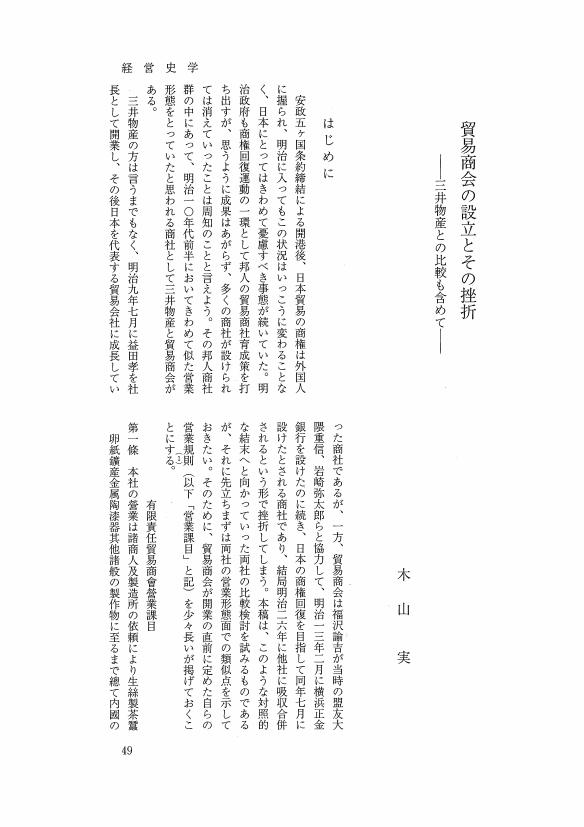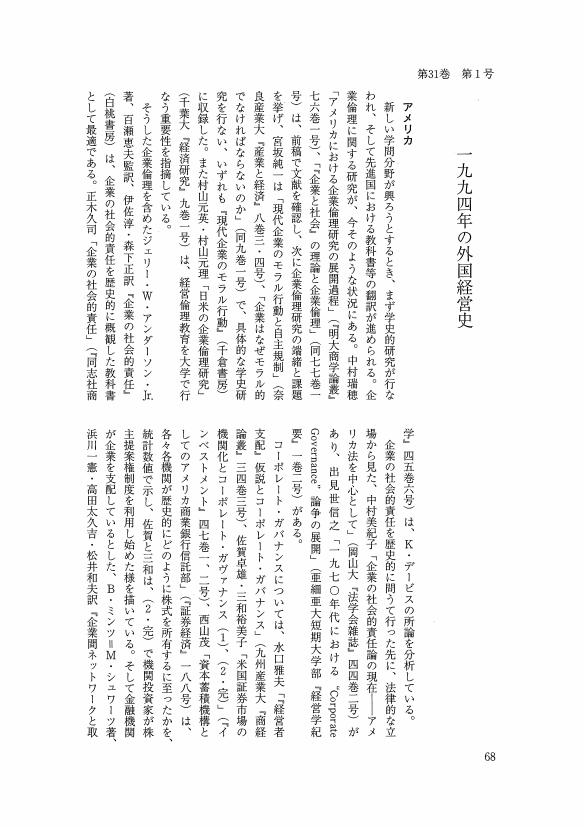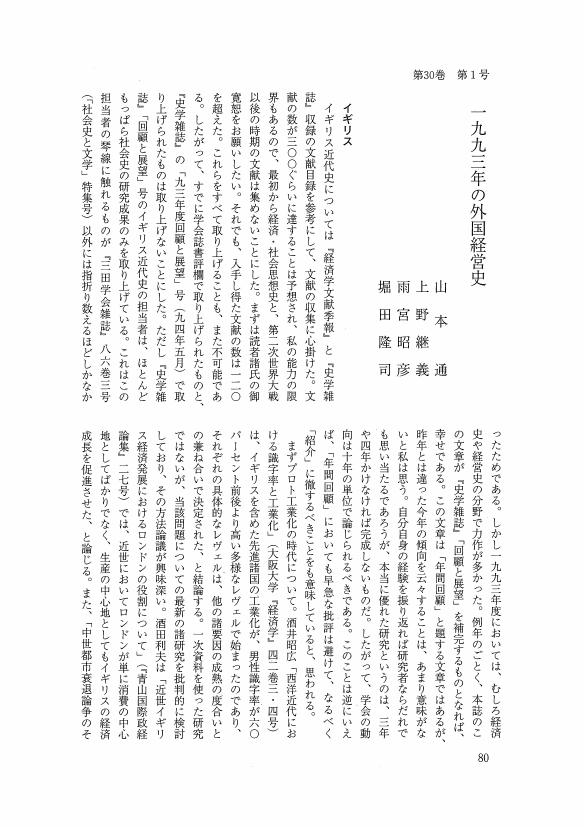1 0 0 0 OA 我が国における百貨店の成立とショーウインドーの導入
- 著者
- 高柳 美香
- 出版者
- 経営史学会
- 雑誌
- 経営史学 (ISSN:03869113)
- 巻号頁・発行日
- vol.31, no.4, pp.32-48, 1997-01-30 (Released:2010-11-18)
1 0 0 0 OA 貿易商会の設立とその挫折 -三井物産との比較も含めて-
- 著者
- 木山 実
- 出版者
- 経営史学会
- 雑誌
- 経営史学 (ISSN:03869113)
- 巻号頁・発行日
- vol.31, no.4, pp.49-72, 1997-01-30 (Released:2010-11-18)
1 0 0 0 OA ライン-マイン-ドーナウ株式会社の成立と活動 -連邦制度の下での「公益団体」-
- 著者
- 渡辺 尚
- 出版者
- 経営史学会
- 雑誌
- 経営史学 (ISSN:03869113)
- 巻号頁・発行日
- vol.31, no.1, pp.1-41, 1996-04-30 (Released:2009-11-06)
- 被引用文献数
- 1
1 0 0 0 OA 一九九四年の日本経営史
1 0 0 0 OA 一九九四年の外国経営史
1 0 0 0 OA 第三一回大会統一論題「国家と企業-規制と組織化の国際比較-」討議報告
- 出版者
- 経営史学会
- 雑誌
- 経営史学 (ISSN:03869113)
- 巻号頁・発行日
- vol.31, no.1, pp.109-126, 1996-04-30 (Released:2009-11-06)
1 0 0 0 OA 工業化と都市木材業の経営 -名古屋・材〓の場合-
- 著者
- 松村 隆
- 出版者
- 経営史学会
- 雑誌
- 経営史学 (ISSN:03869113)
- 巻号頁・発行日
- vol.31, no.2, pp.1-30, 1996-07-30 (Released:2009-11-06)
- 被引用文献数
- 2
This paper intends to make an analysis of management of a timber merchant in the period of industrialization from 1880s to 1920s in Japan. As the target of a case study, the management of Zaisou, a famous timber merchant in Nagoya is chosen. Zaisou has maintained its predominant position in the lumber industry since Edo era. In Meiji and Taisho period, Zaisou started to develop its business of finance, securities, and real estates in addition to the lumber industry.In parallel with the industrialization, the demand of timber, sleepers and wooden boxes were greatly expanded. As a result, Zaisou could not afford to continue its traditional business, namely investment in forests in Kiso district. Under such a business climate, two goals for the growth of the enterprise emerged : acquisition of suitable wood for various kinds of demand, and making steady profits.In order to achieve the former goal, Zaisou diversified the purchasing routes of wood. In the field of wood needed a high quality, for example, such as sleepers, wooden boxes and luxury timber, Zaisou continued to invest in forests as in Edo period. Concerning to the latter target, Zaisou firstly diversified ways of the use of funds, secondly enlarged means of purchasing. It was effective for Zaisou to buy timber in large amount in the shortening turnover of funds and elaboration of inventory management.
1 0 0 0 OA 中国におけるトヨタ生産方式導入の源流
- 著者
- 李 春利
- 出版者
- 経営史学会
- 雑誌
- 経営史学 (ISSN:03869113)
- 巻号頁・発行日
- vol.31, no.2, pp.31-64, 1996-07-30 (Released:2009-11-06)
- 被引用文献数
- 1 1
The purpose of this paper is to examine the origin of the adoption of the Toyota production system in China. In a large context of worldwide Japanization, the Chinese firms paid more attention to and introduced the Toyota production method earlier than American and European firms. First Automotive Works (FAW), the prototype of the Ford production system in China, began to introduce the philosophy of Toyota system under the direct technological instructions by Taiichi Ohno, one of the earliest proponents of the Just-in-Time method in Toyota in late 1970s. They also built a typical Toyota-style transmission plant which received technological assistance from Hino Motor Co. of Toyota Group in late 1980s. These efforts have been contributing to a great extent the evolution of the production system in FAW.FAW invited Taiichi Ohno, who was born in China, to conduct seminars and on-the-spot technological instructions in 1977 and 1981, In FAW, Ohno not only harshly criticized the existing mass production system of FAW, but also taught FAW by showing the example of changing the lay-out of production line. Besides, FAW also sent an observation mission to learn Japanese management methods and visited ten Japanese auto companies for five months in 1978.The FAW Transmission Plant, which introduced Just-in-Time method, is viewed as one of the best plants in China. This paper examines its system from the angles of production and quality control. It also analyzes the conflict between the old and new system during the adoption process of Toyota method as well as the modification of wage system and organization design. FAW is in the middle of learning the so-called “lean production”, and the transmission plant has become a typical model of this system. Every person above manager level has the book “The Machine that Changed the World” (MIT, IMVP). By 1995 thirteen seminars focused on lean production had been held at the FAW Academy of Communist Party.Technology transfer between plants is one of the serious problems in FAW. There is a unique coexistence of different production systems including those of former Soviet Union, Japan, US and Germany because of the deferent adoption time. In general, the evolution process of production system of FAW shows an example of worldwide Japanization and a good direction for the reform of state-owned firms which are in the labor pains of building up competitiveness in an increasingly market-oriented economy in China.
1 0 0 0 OA 財閥史と企業集団史の論理
- 著者
- 橘川 武郎
- 出版者
- 経営史学会
- 雑誌
- 経営史学 (ISSN:03869113)
- 巻号頁・発行日
- vol.30, no.2, pp.31-47, 1995-07-30 (Released:2009-11-06)
1 0 0 0 OA 芝浦製作所にみるワーレン・システム導入の試み
- 著者
- 佐々木 聡
- 出版者
- 経営史学会
- 雑誌
- 経営史学 (ISSN:03869113)
- 巻号頁・発行日
- vol.30, no.2, pp.48-71, 1995-07-30 (Released:2009-11-06)
1 0 0 0 OA 創立期幹線鉄道会社における重役組織の形成 -九州鉄道会社の成立と地域社会-
- 著者
- 中村 尚史
- 出版者
- 経営史学会
- 雑誌
- 経営史学 (ISSN:03869113)
- 巻号頁・発行日
- vol.30, no.3, pp.1-38, 1995-10-30 (Released:2009-11-06)
In the 1880s, a lot of railway companies were established in Japan. Many of them were promoted by provincial governors, for the purpose of stimulating of the development of industry in local communities. Therefore, in the early years, the railway companies had problems becoming independent of local interests.The purpose of this paper is to investigate the formative process of the top-management structure of Kyushu Railway Company from 1886 to 1890, and to shed light on the relationship between a railway company and local communities in modern Japan.The conclusion of this paper is as follows : 1. At the start, the top-management structure of Kyushu Railway Company was a council system, where in the major directors represented local communities. The first aim of the company president was to achieve independence from the representative who disregarded making a profit.2. At first, the president included stockbrokers in the board of directors. There were two purposes for this. One was for smooth fund-raising, and the other was to increase the number of board members opposed to the representative of local communities.3. But fund-raising was stymied by the panic of 1890, and the super-vision of local communities was difficult to overcome. Alternatively, the railway president managed to enlist zaibatu capitalists as stock-holders and brought them on to board of directors, moreover the president issue a bond for new fund-raising. These measures achieved their purpose in 1900, after which the Kyushu Railway Company was no longer dependent on the local communities.
1 0 0 0 OA 三井物産と三菱商事 -戦後の石油ビジネスにおける事業変遷-
- 著者
- 平井 岳哉
- 出版者
- 経営史学会
- 雑誌
- 経営史学 (ISSN:03869113)
- 巻号頁・発行日
- vol.30, no.3, pp.39-68, 1995-10-30 (Released:2009-11-06)
Before World War II, Mitsui-bussan (MBK) was the biggest general trading company in Japan, which used to have a great difference on gross sales from other domestic general trading companies. But nowadays, MBK is one of the five biggest general trading companies (other are Mitsubishi-shoji, Marubeni, Itochu-shoji, and Sumitomo-shoji), so the great lead of MBK from others has been losing gradually after the war.Instead of decling of MBK, Mitsubishi-shoji (MC) had kept the top position on gross sales in 70's and 80's.This contrast between two companies was represented on fuel business, especially on oil business after the war. MC had gained gross sales on the oil business by building a close relationship with petroleum exporting countries and international petroleum corporations, and MC succeeded in importing LNG (liquid natural gas) from Alaska and Brunei.Sales of MBK's oil business were always lower than that of MC. So BMK carried out the project of boring petroleum and producting petrochemical materials at Iran in 70's and 80's. But MBK was suffered heavy losses by failing both of projects.The gap of two companies was derived from the result of the re-unification. After World War II, MBK and MC were dissolved by Occupation policy. Both of companies were divided in many companies. Later, MC accomplished the re-unfication in 1954, and MBK also did in 1959.But, in the process of re-unification, most of competent person on oil division of former MBK organized General-bussan company (General oil company now), and they also acquired all of trade rights on oil business of former MBK. And they didn't take part in the re-unification of new MBK. Therefore new MBK failed to gather human resources and trade rights on oil business.On the other hand, in MC, most of competent person on oil division of former MC moved to other companies, too. But new companies which were founded after dissolution, revived many trade rights on oil business of former MC. And they trained many men talented on oil business. Moreover most of there companies participated in the re-unification of new MC. As a result, new MC successed in gathering human resources and trade rights on oil business.
1 0 0 0 OA 脱古典の時代における人と経営 -相補性complementarityの原理について-
- 著者
- 奥田 健二
- 出版者
- 経営史学会
- 雑誌
- 経営史学 (ISSN:03869113)
- 巻号頁・発行日
- vol.30, no.4, pp.1-31, 1996-01-30 (Released:2010-11-18)
The modernization of human resource management in Japanese industry was realized by way of introduction of various systems from advanced Western countries. The basic philosophy underlying such modern human resource management systems is anchored in the concept of dichotomy.Needless to say, F.W. Taylor's scientific management system is the foremost example of this : the status and role of those in management and those subjected to management are sharply divided. Management monopolizes the power to decide about every minute detail of operation : those at the bottom of the hierarchy just are supposed to obey orders from above.Introduction of Taylor's system into Japanese industry took place in the 1920's, and 1930's, against the background of a fierce debate on how to evaluate scientific management within the Japanese context. One group of industrial engineers argued that workers at the work shop level should be treated not as mere objects of time and motion study, but rather as equal partner in any such study.These engineers attached prime importance to the rich implicit knowledge which workers naturally have on how to improve their own operations. In other word, according to this group of engineers there ought to be no dichotomy between the roles of shop-level workers and engineers; instead they preferred considering these respective roles as mutually complementary.The author wondered what was the origin of the concept of complementarity in Japan. His hypothesis implies that this concept has been an undercurrent of Japanese business philosophy since the middle of the Edo Period, around 1700-1800. Ideas about complementarity between management and labour were typically formulated in the works of thinkers like Ando Shoeki, Ishida Baigan, Ninomiya Sontoku and Tanaka Kyugu; Section II and III of this paper provide on evaluation of such works. Then, in Section IV the author proceeds to analyze the complementarity related philosophy and behavior of business leaders like Ohara Magosaburo, Shibusawa Eiichi and so forth who were active in the 1920's, and 1930's. In addition, Section IV also covers some representative examples of complementarity-based business patterns in the period after WW II, including a few cases of superior performance levels in the development of new car models in the automotive industry.Section V, finally, stresses the author's conviction that the concept of complementarity is not unique to Japan, but rather is of universal value.
1 0 0 0 OA 明治前期における肥前陶磁器業の輸出戦略
- 著者
- 山田 雄久
- 出版者
- 経営史学会
- 雑誌
- 経営史学 (ISSN:03869113)
- 巻号頁・発行日
- vol.30, no.4, pp.32-58, 1996-01-30 (Released:2010-11-18)
Since the Hizen Porcelain Industry had started selling to European, American and Chinese merchants in 1860s, the Arita merchants conceived brands and selected designs to be reflected in the products made by manufacturers. In 1870s, Hizen Porcelain Industry sold on World Exhibitions and exported many products directly to European countries and America. The porcelain companies exported also directly while selling to foreign merchants in Nagasaki and Yokohama. Such strategies were adopted according to the changing conditions in internal and external markets.Around 1890, the Japanese merchants who lost their share in foreign markets gradually shifted to sales of both traditional and modern porcelain products in various national districts. Under unfavorable exporting conditions, Arita merchants united with manufacturers in their production and export activities. This reaction resulted in an integrated brand of Hizen Porcelain Industry which in turn, implied higher competition within the Japanese porcelain market itself.
1 0 0 0 OA アメリカ技術史学会 (SHOT) の動向 -技術と文化との照合・多国籍化-
- 著者
- 小林 達也
- 出版者
- 経営史学会
- 雑誌
- 経営史学 (ISSN:03869113)
- 巻号頁・発行日
- vol.29, no.4, pp.76-86, 1995-01-30 (Released:2010-11-18)
1 0 0 0 OA 訪米生産性向上使節団 -第二次大戦後のフランスの事例-
- 著者
- 原 輝史
- 出版者
- 経営史学会
- 雑誌
- 経営史学 (ISSN:03869113)
- 巻号頁・発行日
- vol.30, no.1, pp.1-41, 1995-04-30 (Released:2009-11-06)
During the period W.W. II, due to the capital assistance of the Marshall plan France experienced a high rate of growth. Productivity missions that were dispatched from France to the United States played a very important role in this growth.The purpose of this paper will be to analyze the role of the French productivity missions to the United States. This analysis will inclued 4 sections. Section I will be an analysis of the organization of these missions. In this section, I will present a clear analysis of the impetus behind the actions of the missions, the 3 different forms that the missions took, and the participants in the missions themselves.The second section will include a look at the origin of the missions, the preparations for the missions and their activities in the US. The contents of this section are based on an interview that I conducted in 1992 with R. Donn. R. Donn was the person at the French embassy in Washington DC engaged in bringing the missions to the US. According to Mr. Donn, plans to visit the US were initiated by the French side. This section will also include a look at the process by which the missions, with the aid of American capital assistance, were realized.The third section will include an analysis of the actual condition of American management that the productivity missions saw. In this section, I will describe the American management methods that appeared in the reports of the missions, American management that was observed by the missions and the American management as was seen by the laborers. Each participant praised the American management system as being very efficient.The fourth section will be an examination of the changes that the missions brought about in France's economy and management. According to ananalysis of the results of a survey of the managers who participated in the productivity missions, many of them after returning to France, applied what they had learned in the US. The missions were very fruitful.As a next step, it would be interesting to analyze, one by one, how the techniques that the industries that participated in the missions learned were applied in each instance.
1 0 0 0 OA 食糧庁における科学的管理法の現代的展開 -政府米鉄道輸送費の標準原価管理制度の導入-
- 著者
- 渡辺 隆夫
- 出版者
- 経営史学会
- 雑誌
- 経営史学 (ISSN:03869113)
- 巻号頁・発行日
- vol.30, no.1, pp.42-55, 1995-04-30 (Released:2009-11-06)
1 0 0 0 OA 一九九三年の日本経営史
1 0 0 0 OA 一九九三年の外国経営史
- 出版者
- 経営史学会
- 雑誌
- 経営史学 (ISSN:03869113)
- 巻号頁・発行日
- vol.30, no.1, pp.113-124, 1995-04-30 (Released:2009-11-06)












